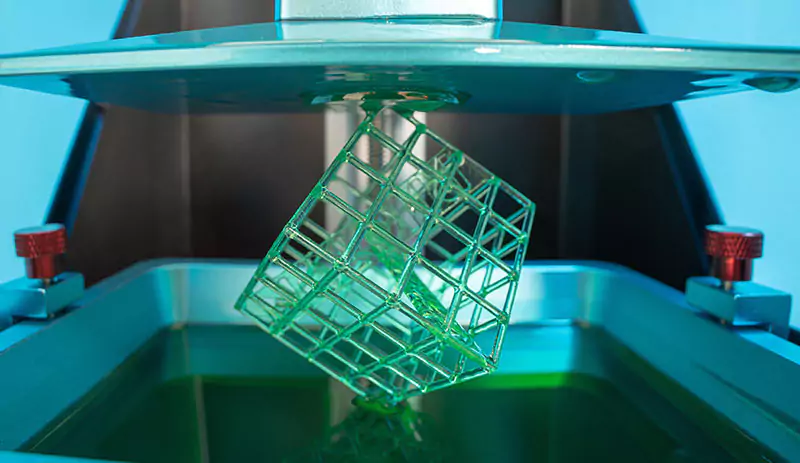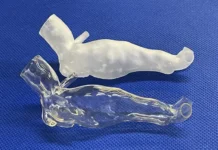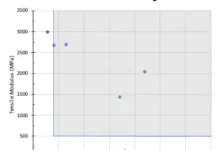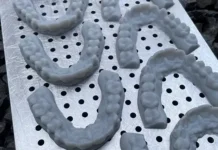By Dianna Brodine, managing editor, UV+EB Technology
Additive manufacturing – or 3D printing – is a rapidly growing technology with applications across a wide variety of markets. From prototyping and tooling to small-scale production and the potential for high-volume manufacturing, the process is only limited by the ability of materials and equipment developers to keep up with the imagination of the engineers anxious to utilize it.
A number of additive manufacturing process types exist, but two of the more popular processes utilize UV technology to cure the printed materials. Stereolithography (SLA) and Digital Light Processing (DLP) utilize UV to cure the layers of resin as a 3D-printed object is built up, typically from a CAD file. A 2019 study by Markets and Markets lists SLA and DLP as holding the fourth and ninth largest market share of the various 3D printing techniques, respectively (Figure 1). Both techniques are expected to grow significantly within the next five years1 in industries from automotive and appliance to jewelry and medical. This article will explore growth opportunities and limitations for 3D printing, with input from various industry studies and subject matter experts from BASF, Carbon and Tactile Materials Solutions.
Global surveys predict growth
Global surveys from industry studies by MarketsandMarkets, Allied Market Demand and IDTechEx agree that the global 3D printing market is prepared to explode with significant growth. Although the numbers vary (MarketsandMarkets predicts market size at $34.8 billion by 2024, while IDTechEx says it will take a little longer – $31 billion by 2029), conservative estimates still anticipate global market size to triple within the next 10 years.
A sampling of text from three industry forecasts follows:
- The global 3D printing market size is estimated to be USD 9.9 billion in 2018 and is expected to reach USD 34.8 billion by 2024. Factors such as ease in development of customized products, reduction in manufacturing cost and process downtime, government investments in 3D printing projects and development of new industrial-grade 3D printing materials are driving the growth of the 3D printing industry.1
- The global 3D printing market was valued at $4,164.2 million in 2014, and is projected to reach $44,393.1 million by 2025, registering a CAGR of 21.8% from 2019 to 2025. North America was the highest contributor to the global market, with $1,728.1 million in 2014, and is estimated to reach $16,838.3 million by 2025, registering a CAGR of 20.8% during the forecast period.2
- IDTechEx forecasts that the global market for 3D printing equipment, materials, software and services is estimated to be worth $31 billion by the year 2029.3
Application and market opportunities
So, what’s driving these growth predictions? Where are the opportunities for material developers, equipment manufacturers and – most importantly – application designers? The interest in 3D printing has been driven by the lure of shorter product development times, the ability to quickly prototype and try out new product ideas and the ability to customize production runs of limited numbers. However, one study reports: “Currently, the trend in the 3D printing applications is shifting from prototyping to functional part manufacturing in various verticals, such as automotive, medical, aerospace and consumer goods.”1
Automotive companies have invested heavily in the technology, as another study reports. “With the help of 3D printing, the manufacturing of lightweight vehicle components is possible for reducing the weight of vehicles, improving car performance and increasing fuel economy. Moreover, higher efficiency can be gained in manufacturing tools for injection molding using this technology.”2
A spokesperson for Carbon, a digital manufacturing technology company based in California, said, “Part lightweighting is a big opportunity in this particular space. In traditional manufacturing processes, making a part – especially a plastic part – often requires filling an entire geometry with material due to the way injection molding works. With an additive process, a minimum amount of material is placed to get a maximum mechanical effect.”
The customization and cost reductions afforded by additive manufacturing make the technology appealing in the healthcare industry. A study commentary on this market opportunity read: “The 3D printing technology has enabled a more patient-centric approach in this field by enabling customization of prosthetics and dentistry and with the help of bio-printing, researchers can print human-sized bones, cartilage and muscles. The time required to produce human body parts is reduced, which curtails the cost of manufacturing artificial body parts. These factors are expected to create lucrative growth opportunities for the 3D printing market in future.”2
The dental industry embraces that same patient-centric, customized approach and was one of the early mass adopters of the technology. “We see one of the biggest near-term opportunities in dental applications,” said Kara Noack, director regional business manager for BASF 3D Printing Solutions NA. “It is by far the most mature market in 3DP photopolymer technologies and driving its largest near-term growth.”
Expansion into new markets is key for future growth of additive manufacturing. From jewelry and consumer products to aerospace, unique applications will drive imaginations. Recent news stories have reported 3D printing applications in the creation of prosthetic limbs, plane interior components, custom eyeglasses and even specialty cake molds. And, opportunities exist for new hardware entries into the space, too, as certain technology firms – including Stratasys and 3D Systems reach the end of their patent terms.2
Much of this expansion has been made possible by increased availability of materials suitable for 3D printing. According to an article by Deloitte, “In 2014, the list of materials that could be used in 3D printing was already long, but still far short of the complete list of materials that are commonly used in parts manufacturing. Plus, many parts need to be made of more than one material, a task to which the 3D printers of the time were not well suited. Fast-forward to the beginning of 2019, and the list of possible 3D-printable materials has expanded to more than double what it was five years earlier, and mixed-material printers are becoming more common.”4
The Carbon spokesperson agreed, saying, “Traditional stereolithography resins used raw materials developed for coatings and paints, but could be limited when formulated into bulk materials. Recent developments have drawn from a broader range of materials options.” These include dual-cure materials that have allowed heat-curable chemistries, like polyurethane and epoxy, to be designed into 3D-printable formulations.
Stephanie Benight, president of Tactile Materials Solutions, a consulting company working with clients in additives, says materials development remains a priority as companies prepare for the new year. “The ability to rapidly print an elastomer that has high elongation, good elasticity, fast rebound and can withstand fatigue in a variety of market applications is a significant opportunity for development. Primarily, the major applications that come to mind are functional parts, like gaskets and shoes. There also is potential in end-of-arm robotic tooling, where you need a high level of fatigue cycling durability and it’s highly desirable to be able to customize on demand in the factory.”
Noack says BASF is working to enable wide adoption of digital manufacturing across its technologies. “With our product line Ultracur3D photopolymer solutions, we are working on formulations to be able to achieve thermoplastic-like behavior for functional parts,” she said. “We are making strides in environmental stability and toughness.”
Benight says the advantages that photopolymers have over other 3D printing technologies leave UV-curable additive manufacturing poised to increase market share. “With the control that users get to achieve by doing the chemical polymerization reaction in the printer, a variety of material properties are possible, lending photopolymers to high-volume manufacturing and customization opportunities.”
Growth limitations
The growth predicted in the 3D printing space comes with a few caveats. First, although equipment costs are significantly lower than when the technology was first introduced, other factors are in play, including energy costs. According to a global study, “There are numerous factors that lead to higher cost of the 3D printing devices. To name a few, the energy taken by 3D printing to produce items is enormous. For instance, the energy released by some of the 3D printing processes utilizes up to 50 to 100 times more electricity as compared to the injection molding machines.”2
Also, despite the expansion of materials availability, limitations still exist. Benight notes concerns about the ability to meet certain industry standards, saying, “The automotive industry is very strict on the standards that materials must meet – and rightly so, because there are safety and reliability concerns. We need to have an accepted set of standards created with photopolymers and the additive technologies that enable them in mind, so these materials can be tested for different manufacturing applications. These standards need to be performed on materials prior to their use for production to build customer confidence.”
She continued, “The reason these tests exist is to avoid massive recalls down the road, so testing is important for safety, consumer confidence and when assessing the costs to remanufacture or replace product. Work is being done in the photopolymer additive community – NIST is creating characterization methods to further understand 3D-printed photopolymers and what should go into those standards, and ASTM has a committee focused on additive manufacturing. It’s going to take an effort from the material developers and equipment providers working with customers in order to adopt standards and build confidence in these materials for mass production applications.”
What’s next?
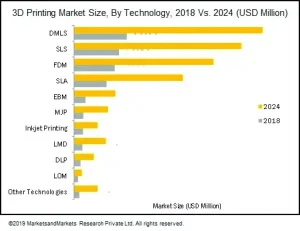 When Benight was asked if 3D printing technology is feasible as a larger-scale production process, she said, “That is literally the question that leads off every symposium on this topic. Everyone in the photopolymer industry – material and equipment – is working toward it, but in order to run, you have to walk first.”
When Benight was asked if 3D printing technology is feasible as a larger-scale production process, she said, “That is literally the question that leads off every symposium on this topic. Everyone in the photopolymer industry – material and equipment – is working toward it, but in order to run, you have to walk first.”
Benight says the first step on that walk is the limited run production that already is occurring. “Limited run production is a step toward those higher volumes that will eventually substantiate the anticipated market growth,” she explained. “If those are successful, customers will see the gains in additive vs. traditional manufacturing, and once those proofs of concepts are seen, there will be wider adoption of photopolymer technology for 3D printing.”
Noack concurs, saying, “3D printer manufacturers are developing new technologies that are making dramatic improvements in throughput as well as the size of parts that can be printed. Also, we are seeing innovative systems capable of new functionality, like multi-material printing, that to date had not been possible. These process improvements – coupled with improved materials – will certainly help to enable production opportunities. Another part of the equation, too, is the end user’s readiness to plan in their product development to take advantage of these new technologies. A new way of thinking in designing for additive is necessary.”
The Carbon spokesperson agreed that hardware and software providers need to work together to increase the feasibility of large-scale production. The company has introduced a new printer to the market with a larger build area, which helps customers reduce print time and make parts more efficiently, bringing producers closer to the high-volume space. “Our partners with high-volume production needs, like adidas and Riddell, can now manufacture parts more quickly and efficiently. For adidas, we produced more than 100,000 pairs of high-performance footwear in 2018 and are scaling production into the millions in the next two years.”
Continued chemistry development also plays a part. “Many of the recent advances have been in incorporating different base chemistries into resins, including hybrid chemistries, rather than solely relying on acrylate-based materials,” said Benight. “These lead to a wider range of material properties for many applications.”
It seems clear that additive manufacturing is creating growth opportunities for companies invested in UV-curable chemistries and equipment. Overcoming the limitations in materials development and testing standards seems achievable with collaboration among equipment manufacturers, materials developers and potential end users.
References
- Markets and Markets: 3D Printing Market by Offering (Printer, Material, Software, Service), Process (Binder Jetting, Direct Energy Deposition, Material Extrusion, Material Jetting, Powder Bed Fusion), Application, Vertical, Technology, and Geography – Global Forecast to 2024
- Allied Market Demand: 3D Printing Market by Technology [Stereolithography (SLA), Fused Deposition Modelling (FDM), Selective Laser Sintering (SLS), Electron Beam Melting (EBM), Digital Light Processing (DLP), and Others], Component (Hardware, Software, and Services), and End User (Automotive, Healthcare, Industrial, Consumer Electronics, Aerospace & Defense, and Others): Global Opportunity Analysis and Industry Forecast, 2019 – 2025
- IDTechEx, 3D Printing 2019-2029: Technology and Market Analysis
- Deloitte Insights article, December 2018: 3D printing growth accelerates again



